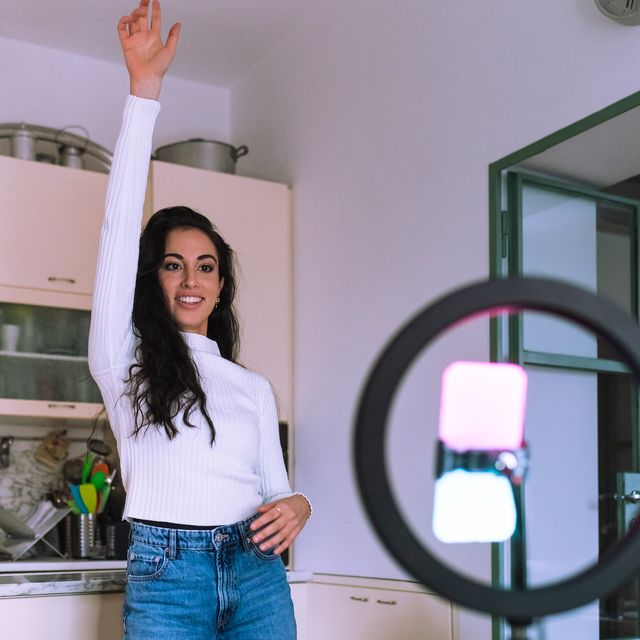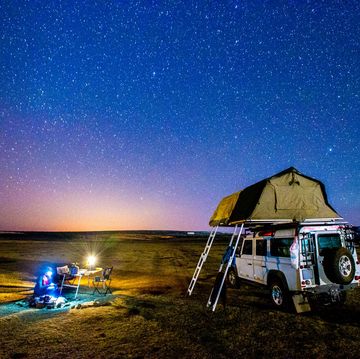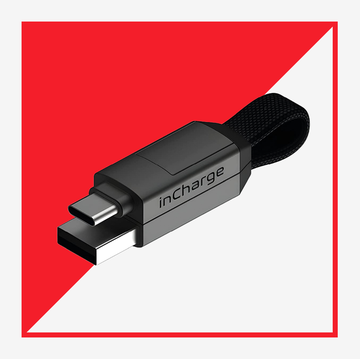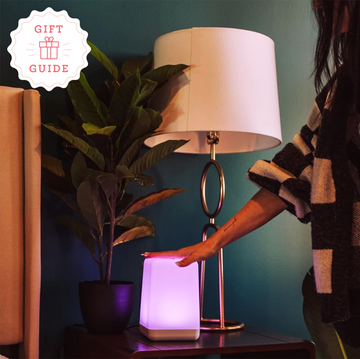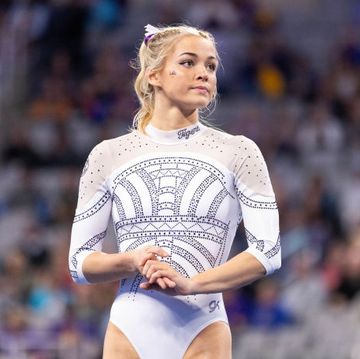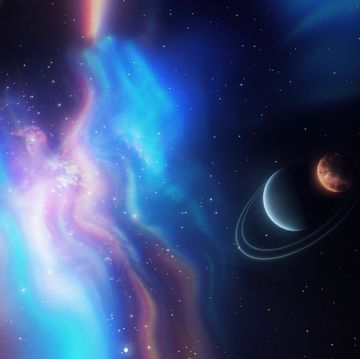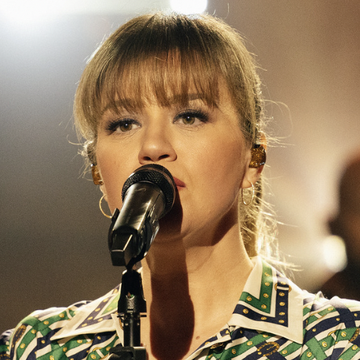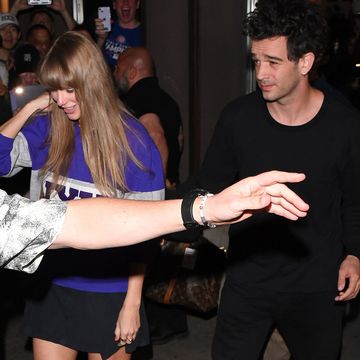POV: Your friend said something in the group chat that you think is hilarious. In response, you send a quick reaction GIF, since GIFs encompass your feelings better than any text could (especially when they’re of someone as witty as Nicki Minaj or RuPaul). Harmless, right?
Well, it’s not that simple. If you’re not Black, using popular GIFs—like Stanley from The Office rolling his eyes, Raven-Symoné chewing her gum at high-speed, or Michael Jordan sobbing—actually means you're partaking in something called digital blackface, which has become increasingly common with the rise of social platforms and digital media.
And nope, GIFs and memes aren’t the only way people commit digital blackface, either. It’s a major phenomenon on TikTok and Instagram Reels, too, specifically when it comes to the use of viral, trending audio featuring the voices of Black people being co-opted by non-Black people.
Picture popular trends like the “material girl” song, or the sound that features Cardi B yelling “what was the reason,” or the TikTok creator saying “it must be nice.” While these popular videos aren’t inherently negative, they become damaging when non-Black people use them as a means to be expressive in a way they wouldn’t normally exhibit in real life. So while you may think you're being funny, you might be inadvertently promoting stereotypes of Black people in the process.
If you’re confused, curious, or currently cringing over your texts and timeline, you’re in the right place. Here's why you should be more conscious of your online choices, so that you don’t cause more damage:
What is digital blackface?
“Digital blackface is when non-Black people use the images and voices of Black individuals to explain emotions or phenomena,” says Jardin Dogan, MEd, EdS, a counselor and educator specializing in Black mental health and creator of the popular Instagram account @blkfolxtherapy. “It’s when people use images to claim Black identity, but they don’t identify as Black.”
As innocent as sharing these images may seem, digital blackface is problematic because it perpetuates negative stereotypes about Black people—namely that they’re typically overly-animated, loud, aggressive, angry, hypersexual, and much more, Dogan explains.
This exaggerated, hostile perception is particularly pervasive on TikTok, where many white and non-Black creators pair audio featuring Black voices with hyperbolic expressions and gestures in a manner they’re promoting as “comedic” but really isn’t.
“In order to put on the voice of a Black woman, they feel like they also have to put on an entire performance as well, which is often quite offensive,” explains Alexis Williams, a TikTok creator with over 200,000 followers and an engineering student at New York University who has written in-depth digital blackface use amongst Gen Z.
Basically, with TikTok, the combination of video and audio takes blackface to a whole new level, says Keri Kirk, PhD, a clinical psychologist at Medstar Georgetown University Hospital. “[Some users] are making the stereotype come to life,” says Kirk.
These stereotypes can impact Black women more than any other demographic, Kirk explains. For example, when Black women see non-Black people being valued for emulating trends or characteristics made popular by Black women, but they themselves do not obtain that same recognition, it can negatively impact mental health, Kirk says.
So again, while these videos might seem like just another fun way to engage with social media, they’re very harmful. And by participating, you are reinforcing the pervasive, negative stereotypes about what it means to be a Black person.
“It is modern-day minstrelsy,” says Kirk.
Yes, you can trace the nature of digital blackface all the way back to minstrel shows.
In the early 19th century, it became a popular form of entertainment for white performers to paint their faces Black and mimic the likeness of Black people for all-white audiences, Dogan says.
“Today, Black men are seen as angry, aggressive, and violent. Those ideas came from minstrel shows,” among other things, Dogan explains. “Black women are seen as hypersexual, angry, and as breeders. That came from the time of slavery.” Essentially, digital blackface is a virtual, contemporary form of the racist shows, Dogan says.
So, while GIFs, memes, and videos may appear harmless from the perspective of non-Black people, it’s actually very easy to see how digital blackface perpetuates systemic racism.
“As a Black person, I experience private cultural racism the most,” Dogan says. “Because there are so many stereotypes about me, they enter the room before I do, and digital blackface gives non-Black people a false understanding of how Black people exist in the world.”
This is why relying on imagery and audio featuring Black people to help you describe your emotions or get a laugh is, ultimately, not okay—especially when systemic racism ensures that Black men, women, and non-binary people consistently struggle to achieve justice, equity, and positions of influence.
Digital Blackface content typically exists to be funny, explains, Riana Elyse Anderson, PhD, assistant professor in the School of Public Health at the University of Michigan. “But because of the historical roots of minstrelsy and entertainment value, to non-Black people they represent an exaggeration, rather than someone who can be an expert on something, or a leader, anything deemed ‘serious.’”
Furthermore, these issues are rooted in minstrelsy not just in the nature of the performance itself, but also in that white performers are profiting both socially and financially off of the likenesses of Black people. On TikTok, the most popular creators can make thousands of dollars per post, and they often use choreography, audio, and mannerisms made popular by Black personalities to do so, Kirk says.
This dehumanization of Black people is what makes stereotypes dangerous.
Think about it this way: A white woman can send a GIF of NeNe Leakes of the Real Housewives of Atlanta rolling her eyes without consequence. But in real life, a Black woman can lose her job for expressing her feelings in a way that others perceive as “sassy” or “angry,” Dogan explains.
And, as it has been proven throughout U.S. history, a Black man can be killed for demonstrating aggression, confusion, or even indifference. Popular GIFs of Kanye West looking serious, Nick Young with question marks around his face, and others, show Black men expressing themselves which, while technically be harmless, can oftentimes be fatal.
Digital blackface is also a form of cultural appropriation because non-Black people are adopting a Blackness that can be shed and taken on as they please, while actual Black people are forced to confront their race daily, without the privilege of letting it go when it’s no longer “cool” or convenient, Dogan explains.
"It also condenses our existence down to a single, oftentimes negative story," she adds.
And whether they know it or not, non-Black people carry these implicit biases of Blackness being laughable or “dumb,” with them beyond the moment they share a GIF or make a video, and probably apply them to interactions with Black folks in their day-to-day lives, Dogan says.
“But Black people are not monolithic,” she explains. “We’re all different.”
Think about why you’re using a specific GIF or TikTok sound in the first place.
In the fight to create a better, more inclusive world for everyone, not using GIFs and memes of Black folks is one of the easiest things non-Black people can do.
“You need to ask yourself what you’re projecting,” Anderson explains. “If putting on an image that’s not your own would not be acceptable in person, is it acceptable online? If you allow any of it to start now, at what point do you draw the line?”
And if you’re an influential social media creator on any platform, it’s important that you do your research before jumping in on the latest viral trends. For example, find out where the trend, meme, or sound that you’re using originates, and ensure that you’re not imposing or being offensive before posting.
If you’re a non-Black person, making it a priority to educate other non-Black people in your social circle about the history and harm of digital blackface can perhaps slow the rapid popularity of the harmful practice, Kirk says.
And when it comes to platforms like TikTok and Instagram Reels, ask yourself this, Williams says: If you’ve used audio featuring Black people before, how are you acting when you use it? Is this how you’d normally portray yourself? And, if not, why might you be exuding a personality different from your own?
“The root of this comes down to the way that we perceive Black people,” Williams says—and it’s time that non-Black folks interrogate this concept within themselves. “In order to combat this, we need to go all the way to the beginning and ask ourselves ‘why?’” Williams explains.
Ultimately, being willing to understand the consequences of certain actions and then changing those behaviors for the betterment of others is an important part of ongoing anti-racist work. “Instead of sending that GIF, find another one,” Dogan says. “It may take a little bit more time, but at the end of the day everyone has a role to play in dismantling racism.”
Dogan’s final words on digital blackface? “Just don’t do it.”
Madeline Howard is a writer, editor, and creative based in Brooklyn. Her work has been published in Esquire, Nylon, Cosmopolitan, and other publications. Among other things, she was formerly an editor at Women’s Health. Subscribe to her newsletter ‘hey howie’ at madelinehoward.substack.com.
